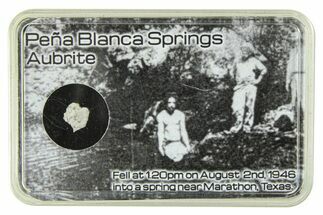This Specimen has been sold.
0.17" Aubrite Meteorite Fragment (0.04 g) - Kansas
This is a 0.17" fragment (0.04 grams) from the Norton County meteorites, an unusual kind of achondrite called an aubrite that fell near the town of the same name in South Carolina in 1843. It comes in a bespoke acrylic display case.
This meteorite is one of the largest aubrites known! This stone tips the scales at just over one metric ton. It fell in Norton County in eastern Kansas on February 18, 1948: eyewitnesses recalled a fireball, sonic boom, and a subsequent shower of stones. Later that April, a team from the University of New Mexico came to the area to collect samples, including the 1,070-kilogram main mass. That main mass is still on display at the university today!
Norton County is the largest aubrite--and stone meteorite in general--to ever fall in the United States, and one of the largest stone meteorites ever found. It is a breccia characterized by abundant white enstatite crystals and occasional iron grains in a darker gray matrix. The enstatite found in this meteorite is well known for being particularly iron-poor: it is so low in iron that it glows yellow under short-wave ultraviolet light!
Norton County is the largest aubrite--and stone meteorite in general--to ever fall in the United States, and one of the largest stone meteorites ever found. It is a breccia characterized by abundant white enstatite crystals and occasional iron grains in a darker gray matrix. The enstatite found in this meteorite is well known for being particularly iron-poor: it is so low in iron that it glows yellow under short-wave ultraviolet light!
About Aubrites
Aubrites are a unique class of achondritic meteorites that represent some quite extreme formation conditions in the early solar system. Aubrites are almost all breccias consisting of whitish enstatite, with occasional inclusions of olivines, nickel-iron, and troilite, along with impact-melted clasts seen in achondrites.
Enstatite is a form of orthopyroxene that forms in igneous conditions and is considered an early stage of mineral formation in the solar system. Enstatite meteorites likely originate from E-type (enstatite-rich) asteroids close to the sun, particularly the near-Earth object 3130-Eger. It has even been observed outside of the solar system around evolved stars and planetary nebulae!
Aubrites are a unique class of achondritic meteorites that represent some quite extreme formation conditions in the early solar system. Aubrites are almost all breccias consisting of whitish enstatite, with occasional inclusions of olivines, nickel-iron, and troilite, along with impact-melted clasts seen in achondrites.
Enstatite is a form of orthopyroxene that forms in igneous conditions and is considered an early stage of mineral formation in the solar system. Enstatite meteorites likely originate from E-type (enstatite-rich) asteroids close to the sun, particularly the near-Earth object 3130-Eger. It has even been observed outside of the solar system around evolved stars and planetary nebulae!
About Achondrites
Achondrites are a type of stony meteorite that lacks chondrules--round grains that aggregate from molten or partially molten droplets in space to form chondrites. Achondrites still contain grains, but their textures are extremely distinct and analogous with igneous processes rather than the chondrule-producing conditions at the beginning of the solar system.
Achondrites make up about 8 percent of all known meteorites. They are almost all regolith breccias, ejected from impacts on larger asteroids and sometimes the moon and Mars. Most are HED (howardite-eucrite-diogenite) in composition, sourced from the asteroid Vesta: it is the second largest asteroid in the Solar System and the only asteroid visible to the naked eye.
Achondrites are a type of stony meteorite that lacks chondrules--round grains that aggregate from molten or partially molten droplets in space to form chondrites. Achondrites still contain grains, but their textures are extremely distinct and analogous with igneous processes rather than the chondrule-producing conditions at the beginning of the solar system.
Achondrites make up about 8 percent of all known meteorites. They are almost all regolith breccias, ejected from impacts on larger asteroids and sometimes the moon and Mars. Most are HED (howardite-eucrite-diogenite) in composition, sourced from the asteroid Vesta: it is the second largest asteroid in the Solar System and the only asteroid visible to the naked eye.
TYPE
Enstatite Achondrite (Aubrite)
LOCATION
Norton County, Kansas
SIZE
0.17" wide, 0.04 grams
CATEGORY
SUB CATEGORY
ITEM
#285990
 Reviews
Reviews












